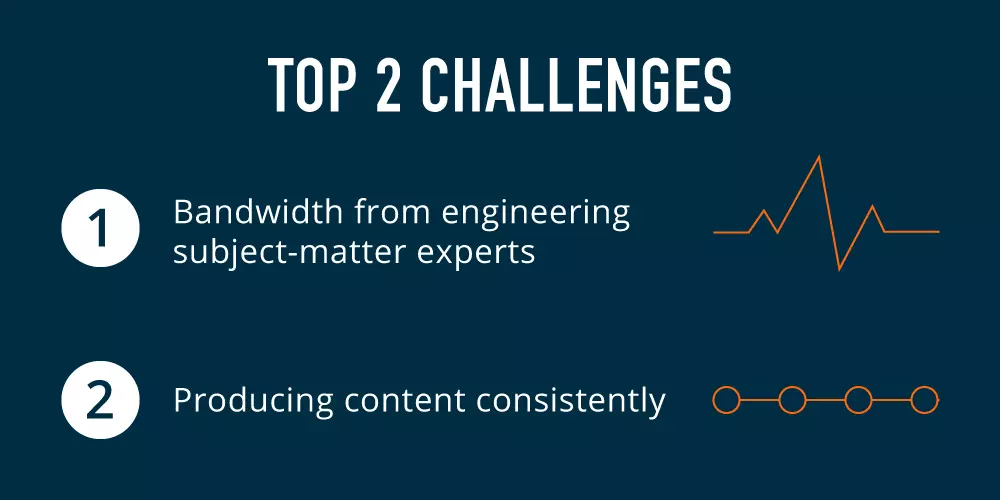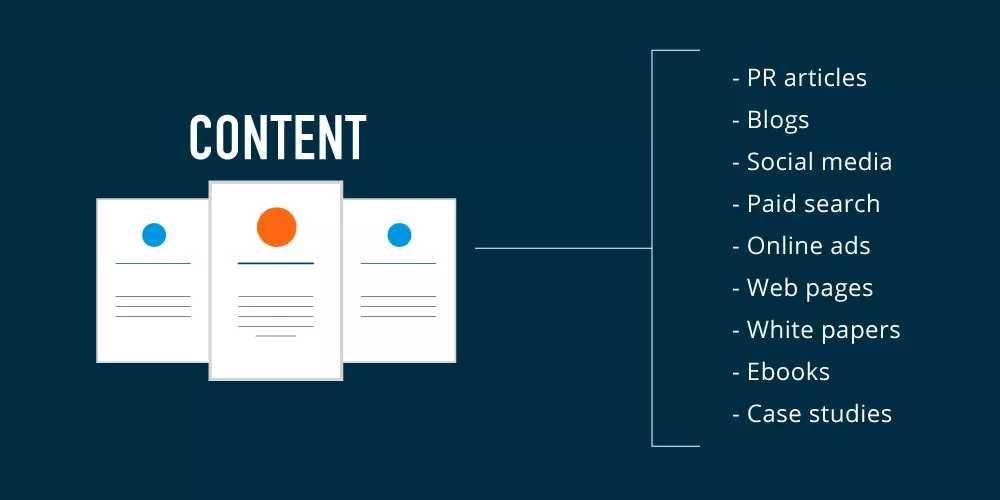Making the Most of Your B2B Content Creation Resources

B2B marketers are struggling to develop the content they need for their content marketing programs. But we’d like to propose a technique that makes content creation more efficient.
Content marketing has established itself as a key component for most marketing programs, both business-to-consumer and business-to-business—justifiably so. It’s based on some timeless marketing principles—giving something of value to prospects, making potential customers aware of your products or services and being a trusted source of information.
B2B has always done content marketing, whether companies have been calling it by its official name or not. B2B marketing usually requires communicating critical and often technical information to targeted audiences, so content has always been the fuel driving our efforts.
Unfortunately, the increased emphasis on content and the rising number of new marketing channels has caused some problems for would-be B2B content creators.
According to a recent study by TREW Marketing, the two most serious problems for B2B marketers are getting bandwidth from their in-house subject matter experts (SMEs) and producing content consistently.

Nor is TREW alone in singling out content creation as a sticking point. Previous studies by ClearVoice and the Content Marketing Institute show similar concerns, as well as problems with integration, measurement and budget.
The difficulties B2B marketers are reporting with generating content are neither surprising, nor are they new. In addition to the obvious conclusion that B2B content creation is really a challenging pursuit, there are several reasons why marketers are having difficulty generating B2B content.
Information Availability
With B2C content generation, the core information is usually readily available. A simple Google search will often turn up the information a writer needs to develop that material: the calorie content of a hamburger, the fuel efficiency of an SUV or the interest rate for a home mortgage.
For B2B content, information is often not that easy to access. Topics are more specialized. More focused. Not “how to make paper,” but rather “how to remove starch from recycled cardboard.
The information may even be proprietary, meaning it was developed through the company’s independent research or its unique experience or capabilities. And it has economic or competitive value—information not available to the general public (especially competitors).
Worst of all, it may only exist in the brain of one very smart person: your subject matter expert (SME).
The SME Challenge
Most SMEs are involved in their company’s most strategic, proprietary, competitive pursuits. As a result, there are serious demands on their time and marketing is not at the top of their list. As a result, marketers are finding that SMEs don’t have a lot of interest in editing and revising marketing materials.
New Communication Channels
What we called fragmentation of marketing channels ten years ago continues at an amazing rate. New platforms and new communications tools crop up all the time. Instagram, Snapchat and Pinterest, for instance, are all less than ten years old and Facebook is only 15. Plus, there’s little to stop an association or trade pub from launching a highly specialized social media forum in your industry, either on their own platform, in a LinkedIn group or on some other platform. And then there’s even more personalized efforts, like marketing automation and account-based marketing. Each of these has its own specific standards and requirements to boot.
It can be a daunting task to stay on top of the new tools and resources your audience is using and to find ways to adapt their technically-driven content to the specialized needs of individual platforms.
One Possible Solution: Core Content
In my experience, many B2B marketers are actually making these problems worse by taking an approach that is highly reactive. Scattered. Tactical. Thinking in terms of separate, isolated Twitter or Facebook posts, email campaigns or marketing automation content.
That’s not the best use of your resources, internally or externally.
A technique we have implemented on a few occasions takes a much different approach. It requires a longer view than is often associated with a single project.
Rather than focusing on individual channels or platforms, we’ve successfully organized entire programs around major topics, compiling all the information we need and creating a source document capturing all that data.
That content then serves as the source material for the entire program. We call this approach “core content creation.”

What is Core Content?
Core content, quite simply, is the collection, assimilation and storage of information about a specific technology or important issue in an industry. It may draw on dozens of sources, but, in the end, it is a single document capturing everything you want to say about a specific topic. It needs to be comprehensive as well as modular, allowing it to be mined or subdivided into articles, blogs or social posts addressing specific points.
The goal is to gather the information in a single document or file and have it approved by the SME. This content then becomes a resource to launch a content marketing program by using any media or channels available: social, PR, email, web or paid placements.
Core content is something we’ve always done. Usually, experienced B2B copywriters have accumulated knowledge about a clients’ key subject areas on a case-by-case, job-by-job basis. Maybe they capture the information somewhere, maybe they don’t. Maybe it’s planned, maybe it ‘sn’t. Unfortunately, however, the creation of core content is rarely scheduled and budgeted.
You can create significant efficiencies if you create a core content resource, the starting point of your content marketing program.
The Benefits
B2B marketers will benefit from core content creation in a number of ways.
- SME Access. The most immediate is in use of an SME’s time. Once they understand that they are signing up for a focused, strategic program rather than a series of disjointed tactics, SMEs are much more willing to participate. They quickly see the project as a good use of their time, offering them the opportunity to promote themselves and their expertise in a way that is both beneficial to the company and flattering to their SME’s ego.
- Marcom support. It’s an important lift to an integrated marketing communications program, especially for a company positioning itself around thought leadership and innovation. It’s a great opportunity to tell audiences how your products change the world and how they create competitive advantages or differentiations for your customers—a significant boost for lead generation as well.
- Agility. Core content also gives us the opportunity to respond to the new marketing channels mentioned above, capitalizing on them as quickly as possible with already approved content. That allows us to focus on mastering these new tools and not on the technical accuracy of the content. Conversely, without core content to rely on, our uptake of new tools and channels will be plodding, at best, which is certainly not the agile response we expect.
- MA and ABM support. Development of this core content approach supports two evolving marketing technologies, marketing automation and account-based marketing. These are predicated on having content available to be sliced and diced to create customized, even personalized, communications. The challenge of providing accurate, customizable content is one factor that has been cited as hindering adoption of these advanced marketing techniques in B2B.
- Accountability. Most of all, core content is the first step in organizing marketing tactics into powerful, integrated campaigns that achieve business goals and can be measured for effectiveness and Return on Investment (ROI).
- Knowledge preservation. In addition, we view our core content offering as a poor man’s knowledge management system, preserving existing expertise and intellectual capital, in the event that an expert leaves the client’s employ for any reason. Most importantly, it helps our clients take full advantage of the intellectual capital inside their walls, maximizing not just their ROI, but also their ROE (Return on Expertise), ROC (Return on Content) and ROK (Return on Knowledge).
Future Uses
New intelligent content technologies also create the potential to automate generation of content tactics from email to social media to articles, white papers and e-books. (Jenn Vitello introduced this concept in a recent blog.) Based on our experience thus far, it will not be easy and it will require new content creation skills, especially the development of information that is both broad and high-level, but detailed and technical, self-contained and even atomized.
When we reach the most advanced stage of intelligent content, a well-structured core content system could also help clients meet other needs, including training, customer service, knowledge retention, data sheets, service information and manuals.
Core Content: A Summary
It’s a six-step process:
- Define your objectives. How important is this topic, strategically? Is it worth the investment of your SME’s time? And does it merit the creation of a marketing communications campaign?
- Get organized. Outline the information clearly. Who is the audience for this information and what do they need to (and want to) know?
- Create the core content first. Before diving into tactics, gather the information. Create a resource document to be approved by your SME and update it when there are new things to discuss.
- Develop a campaign. When you finally get to tactics, make sure the creators of your email campaigns, social posts and web pages understand the core content information. Make sure they know what role their communications will play in the total campaign.
- Mine that content incessantly. Creators of social posts or email should constantly be going back to the core content document as a source for inspiration and new ideas.
- Measure the results. If you’ve done your job, each tactic should have its own key performance indicators (KPIs) determining how well it’s doing in advancing the campaign.
The ultimate goal, of course, is to maximize your company’s intellectual property in a way that positions your company as a thought leader, thereby attracting customers and prospects who value your expertise and recognize its capacity to solve problems, build competitive advantage and transform their companies.
Sign Up for our Newsletter - Get agency updates, industry trends and valuable resources delivered directly to you.
Godfrey Team
Godfrey helps complex B2B industries tell their stories in ways that delight their customers.




